
by Dr. Lori Verderame
Sterling silver is a commonly used and highly collected metal. Silver has been the metal of choice for such collectible objects as Colonial tea sets, Native American jewelry and Old Pawn Indian jewelry, even Olympic collectibles and Olympic medals. The term sterling silver refers to objects that contain 925 parts per 1000 parts pure silver. The other 75 parts in the 1000 parts of sterling silver is usually copper for strength and durability. According to the Federal Trade Commission’s jewelry guidelines, items that are stamped with the words “sterling silver” must have these properties.
What to Look For

Sterling silver pieces must, by law, be clearly marked. There are a few well known ways that sterling silver is marked using symbols, numbers and letters. An acceptable mark for sterling silver is the word “sterling” or “sterling silver” spelled out on a piece of sterling silver. Another required mark is an image or depiction of a striding lion facing left called the lion passante. And, the most common sivler mark, arguably, is the number 925 to indicate the 925 parts silver purity standard or that a piece is 92.5% pure silver within the object. These marks indicate value, fineness, and quality of a piece and have been widely used over the years. Like decoding and understanding pottery marks and other identifying markings on art or antiques, if you can’t find the marks that tell you that you have a piece of sterling silver, you probably don’t have a piece of sterling silver. But, I have also seen many people overlook these marks just because they don’t know where to look or what marks to look for. Then, I amazingly find the mark when they bring a piece to one of my events or send me a photo for review. Look for large pieces with good weight, quality designs, and decoration on pieces of sterling silver.
Whether you have a piece of jewelry, tea sets, or other silver pieces like platters or trays, look for the marks and identifying indicators on the piece. Places to look for the marks are varied. For instance, a mark may be found on the underside of a silver piece and it may be clear and easily recognizable. A mark may be found close to the bottom of a piece or found marked around the base of a piece in a form of a hallmark noting sterling silver and a maker’s mark or date stamp. Silver marks may be on the underside of a teapot’s lid too or it may be placed on the back of a piece of sterling silver flatware. You might not see a sterling silver mark immediately, but look around it should be there if you have a true piece of sterling silver.
Sterling Silver Flatware
Sterling silver flatware or silverware, that’s forks, spoons, knives for dinner service, is some of the most common sterling silver that people have in their homes or collect. Many people have collected silver flatware over time or have inherited silver flatware from family members as heirlooms or gifts. Sterling silver spoons, knives, forks and other serving pieces liked spatulas and cake servers or tongs are typically marked sterling on the back side of each piece and they often have the maker’s mark like Gorham, S. Kirk & Sons, or Tiffany & Co. or another maker’s mark on the back. These pieces may also have a mark that states a pattern name like Rosebud, Seafarer, or Federal, etc. You know you have a piece of sterling silver flatware if your piece has the word “sterling” or the number “925” on the back of each individual spoon, knife, or fork. Flatware can be very valuable and quite collectible on the retail market. While many people incorrectly state that sterling silver flatware is not valuable, that is not true if you have a set or just one piece of sterling silver. People still collection, trade, and resell sterling silver flatware and look for specific patterns, items, and styles of sterling silver flatware too. Many of the most valuable styles are manufactured by the well-known, elite and high-quality silver flatware makers dating from the late 19th Century (1800s) to the late 20th Century (1900s). From the late 1800s to the mid 1900s are the periods when high end entertaining with sterling silver flatware was all the rage.
Look for sterling silver flatware sets that are clearly marked and that retain specialty pieces like shrimp forks, long iced tea spoons, chowder spoons with large round bowls, fish knives, and other pieces that match an existing silverware set. Also, if your sterling silver flatware service for 8 or service for 12 has coordinating or matching serving pieces like cake servers, fruit serving spoons, ice cream scoops, ladles, oversized serving spoons, asparagus tongs, or large bread loaf knives in sterling silver, then these serving pieces will greatly impact the value of your entire flatware set in sterling silver. In addition to flatware sets which usually consist of a matching set of forks, spoons, knives numbering 8 or 12 or more pieces of each type, if you have more pieces then the value of the service will rise. Make sure the pattern is the same and look for exact markings which will indicate if you have a set that was purchased at the same time versus a set that was accumulated in the same pattern but purchased over several decades. In this case, the pattern will look the same but the markings will be different.
If you have a storage box which is felt or velvet lined for your silverware, keep your sterling silver flatware in the box and keep the box closed when your sterling silver is not in use. If you don’t have a sterling silver flatware storage box with individual compartments or areas for forks, spoons, and knives, then wrap your sterling silver in silver bags and store them in a dining room hutch or china cabinet drawer. Do not store wrapped sterling silver flatware on top of each other. Do not store unwrapped sterling silver flatware as the pieces can be scratched or dented by other pieces especially knives which may be hollow. It is very important to keep your sterling silver properly stored so the pieces will retain their good condition and monetary value.
Other types of Silver
There is also silver that is 800 parts per 1000 parts pure silver known sometimes as Mexican silver as well as silver that is 835 parts per 1000 parts pure silver which is often the silver standard used in parts of Europe and Scandinavia. Germany silver or nickel silver refers to a metal with a silver appearance or color that has no elemental silver content. German silver or nickel silver is typically made up of 600 parts copper, 200 parts zinc, and 200 parts nickel to make a complete 1000 parts. These other types of silver are important to know so you can assess the quality of your sterling silver, which is 925 parts per 1000 parts pure silver. For instance, Mexican silver is typically 800 to 900 parts per 1000 parts pure silver and that is often clearly marked on pieces of silver from Mexico, Central or South America like pieces of Taxco, Mexico jewelry and other collectible items. German silver or nickel silver refers to a metal with a silver appearance or color that has no elemental silver content. German silver or nickel silver is typically made up of 600 parts copper, 200 parts zinc, and 200 parts nickel to make a complete 1000 parts.
What is Coin Silver?
Coin silver is a type of silver that contains 900 parts per 1000 parts along with 100 parts of another metal. This silver with a 900 purity level was often called coin because over the centuries government silver coins were melted down to make other objects with this silver content like pieces of fine jewelry, tea sets, tankards, etc. This was done before commercial sheet silver was widely available.
Polishing silver
Less is more when it comes to polishing sterling silver. Here comes the good news about silver, particularly pertaining to sterling silver and its care. Sterling silver should not be excessively polished. That’s right, I just cut down your workload since you should not polish sterling silver too often. Polishing silver can be abrasive to the piece. Polishing silver can result in scratching off a full layer of the silver’s surface and that is never a good thing to do. All this polishing can damage the integrity and quality of your sterling silver object, so be careful and don’t be overzealous polishing your silver. It is best to polish your sterling silver pieces no more than twice a calendar year. That’s the standard rule so you don’t polish your silver surfaces too much. Every time you polish a piece of silver you run the risk of scratching off one thin layer of sterling silver and losing that silver amount.
When you polish, use a soft cloth. Sit down when you are going to polish your silver pieces and this should be your position when you are going to clean any of your art or antique pieces too. Why? You don’t want to drop it and possibly dent or damage the piece. I know it sounds odd but you have a better chance of dropping something and causing damage if you are standing up rather than if you are seated. Don’t try to do a quick polishing job on your sterling silver pieces. If you don’t have ample time to polish your sterling silver pieces, then do it later. Take your time when you are polishing your silver and be ready to polish all the silver that you want to use or display at the same time. If you polish a few pieces now and a few pieces later, then they will tarnish at different rates and you will find yourself polishing silver more and more often and nobody wants to do that. I remember at one of my appraisal events that an audience member told me that she was punished as a child for doing something wrong by being forced to polish the silver. Be gentle and remember the good news… don’t over polish the sterling silver. Be gentle with it and you will enjoy your sterling silver pieces for years to come.
Is sterling silver valuable? In a word, absolutely! Like the gold market, the silver market will experience changes over time but sterling silver remains a highly sought after metal and depending on the piece, it will bring great monetary value to its owners.
Get an online appraisal report on your sterling silver piece from Dr. Lori.


